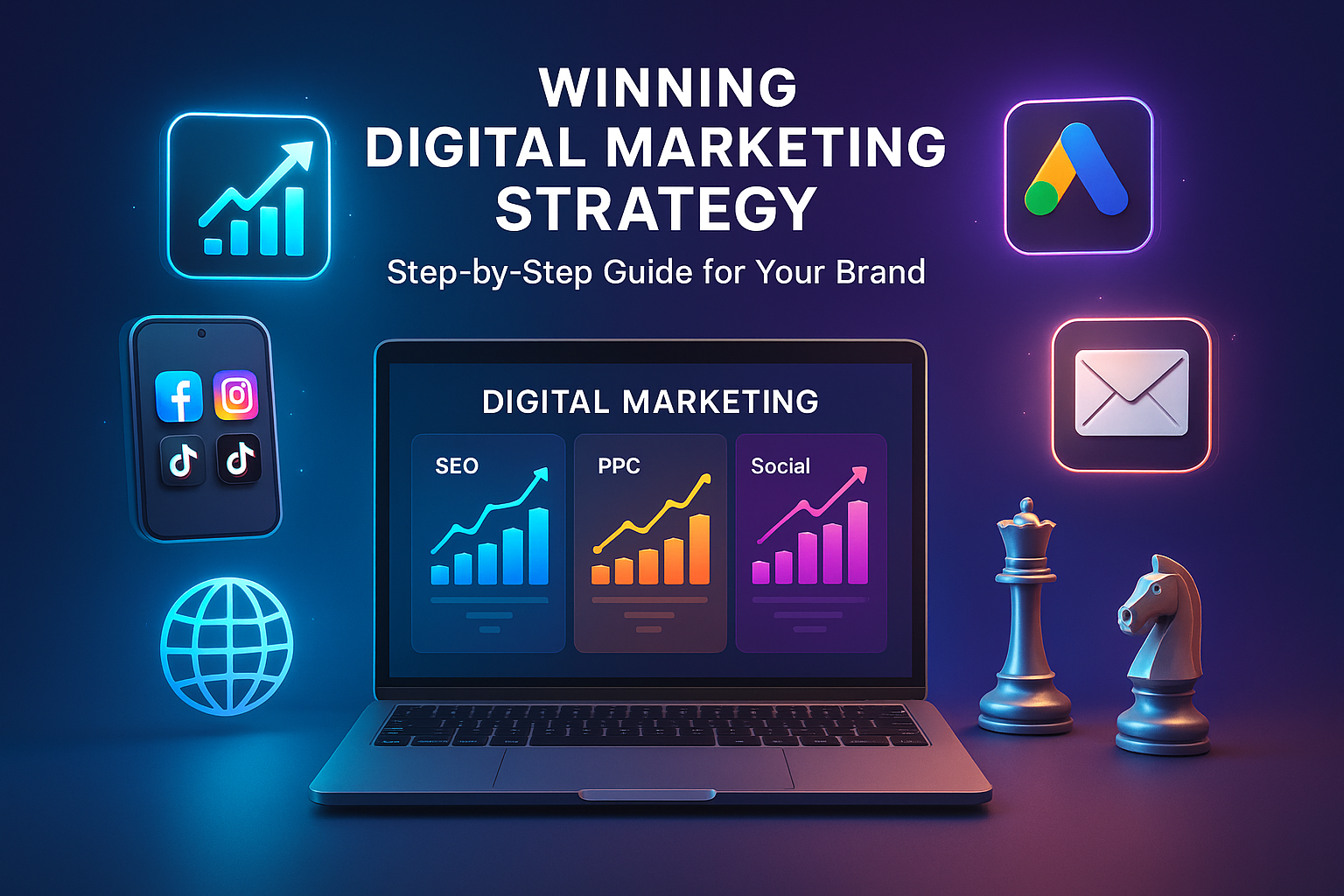In today’s hyper-competitive marketplace, a strong digital marketing strategy is no longer optional—it’s a necessity. To build lasting brand visibility, engage your audience, and drive measurable growth, businesses must create a structured, data-driven approach to digital marketing. Below, we outline a step-by-step guide to building a winning digital marketing strategy that aligns with your brand’s goals and positions you ahead of your competitors.
1. Define Your Brand’s Mission and Goals
Every successful strategy begins with clarity of purpose. Establish a clear mission statement that defines what your brand stands for, who it serves, and how it adds value. From there, create SMART goals (Specific, Measurable, Achievable, Relevant, and Time-bound) to ensure that your strategy is results-driven.
For example, instead of saying, “We want more followers,” define your goal as, “Increase Instagram followers by 30% in the next six months.” This structured approach enables better tracking and accountability.
2. Understand Your Target Audience
Without a deep understanding of your audience, even the most creative campaign will fail. Invest in comprehensive audience research to uncover demographic details, psychographics, pain points, and digital behaviors.
- Demographics: Age, gender, income, occupation.
- Psychographics: Interests, lifestyle, motivations.
- Digital Behavior: Preferred platforms, online purchase habits, engagement trends.
Using tools such as Google Analytics, Facebook Audience Insights, and customer surveys can help create detailed buyer personas. These personas act as a blueprint for crafting targeted campaigns that resonate with your ideal audience.
3. Conduct a Competitive Analysis
To outperform competitors, you must first understand them. Conduct a thorough SWOT analysis (Strengths, Weaknesses, Opportunities, Threats) of your competitors’ digital marketing strategies. Analyze:
- The platforms they dominate.
- The type of content they publish.
- Their SEO rankings and keyword focus.
- Paid advertising strategies and messaging.
Competitive benchmarking will uncover gaps in the market that your brand can exploit.
4. Optimize Your Website for SEO and User Experience
Your website is the digital headquarters of your brand. To attract and convert visitors, it must be search engine optimized and provide a seamless user experience (UX).
Key SEO and UX Optimization Tactics:
- Implement keyword research using tools like SEMrush or Ahrefs to target high-volume, low-competition keywords.
- Optimize on-page SEO: title tags, meta descriptions, alt text, and internal linking.
- Ensure mobile responsiveness and fast loading speeds.
- Design with intuitive navigation to reduce bounce rates and improve engagement.
- Create pillar content and blog posts that establish topical authority in your niche.
A well-optimized website is not only attractive to search engines but also to potential customers who value convenience and accessibility.
5. Create High-Quality, Value-Driven Content
Content is the backbone of digital marketing. To establish authority and build trust, brands must consistently produce content that educates, entertains, and inspires.
Content Marketing Strategies to Implement:
- Blogging: Long-form, SEO-optimized articles that answer user queries.
- Video Marketing: Tutorials, explainer videos, product demos, and live streams.
- Infographics: Visual storytelling to simplify complex information.
- Case Studies and Whitepapers: Establish expertise in your industry.
- User-Generated Content: Reviews, testimonials, and social shares to enhance credibility.
6. Build a Multi-Channel Social Media Presence
Social media platforms are essential for brand visibility and customer engagement. A winning strategy leverages multiple platforms while tailoring content to each audience.
Best Practices for Social Media Success:
- Create a content calendar to ensure consistency.
- Leverage storytelling and interactive posts (polls, quizzes, Q&A sessions).
- Use platform-specific strategies:
- Instagram & TikTok for short-form video.
- LinkedIn for B2B thought leadership.
- Facebook for community building.
- Instagram & TikTok for short-form video.
- Monitor analytics to identify top-performing posts and replicate success.
Paid social media campaigns can further extend reach, especially when paired with advanced targeting options.
7. Leverage Email Marketing for Nurturing Leads
Despite new platforms, email marketing remains one of the highest ROI channels. Personalized, segmented email campaigns help move prospects through the customer journey.
Email Marketing Best Practices:
- Segment subscribers by behavior and interest.
- Personalize subject lines and content.
- Automate campaigns for onboarding, abandoned carts, and re-engagement.
- Provide consistent value—exclusive content, promotions, and insider insights.
Email builds long-term customer loyalty when executed effectively.
8. Invest in Paid Advertising (PPC & Social Ads)
While organic strategies build credibility, paid advertising accelerates growth. Platforms like Google Ads, Facebook Ads, and LinkedIn Ads offer precise targeting to reach your ideal audience.
Tips for Maximizing Paid Campaigns:
- Conduct A/B testing on headlines, visuals, and CTAs.
- Use retargeting campaigns to re-engage visitors who didn’t convert.
- Monitor conversion metrics to optimize ad spend.
- Blend search ads, display ads, and social media ads for comprehensive coverage.
Paid campaigns complement organic efforts, creating a balanced digital ecosystem.
9. Track Performance with Analytics and KPIs
A winning digital marketing strategy is data-driven. Continuous monitoring ensures that campaigns remain effective and adaptable.
Essential Metrics to Track:
- Website traffic and conversion rates.
- Keyword rankings and organic search growth.
- Social media engagement (likes, shares, comments).
- Email open rates and click-through rates.
- Return on Ad Spend (ROAS) for paid campaigns.
Use platforms like Google Analytics, HubSpot, and SEMrush to generate actionable insights.
10. Continuously Optimize and Innovate
The digital landscape evolves rapidly. To stay ahead, brands must adapt, innovate, and optimize. Regularly test new content formats, explore emerging platforms, and refine strategies based on data insights.
A commitment to continuous improvement ensures that your digital marketing strategy not only remains relevant but also delivers sustainable long-term success.
Final Thoughts
A winning digital marketing strategy integrates research, creativity, and data-driven execution. By defining goals, understanding your audience, creating compelling content, optimizing for SEO, leveraging multiple channels, and tracking performance, your brand can rise above competitors and achieve measurable growth.
Follow Us | Our Services | Contact Us | Linkedin | Instagram







